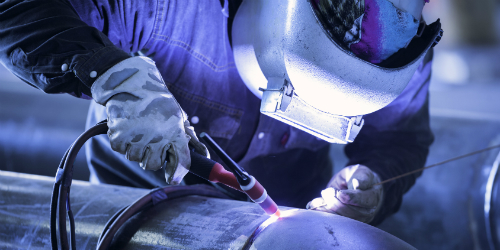Welding Safety

One of the most dangerous tasks in any facility or construction project is welding. Commonly referred to as “Hot Work” this task involves many hazards and exposures. Welding involves the melting of metals using cutting processes as well as joining processes to effect strong bonds. Soldering is a simple form of welding which can be hazardous if not performed safely. Soldering mostly uses heat as a conduit for bonding two metals and is common in smaller operations, especially in the electronics industry. Larger welding projects, such as in construction or heavy equipment manufacturing, involve the use of compressed gases and open flames. This process produces metal to metal bonds that generate a lot of heat, sparks, fumes, and other particulates. A variety of metals is used as the bonding agent in welding depending on the materials being bonded. These agents are hazardous and can also cause an exposure if proper protection is not in place.
Workers performing welding tasks must wear personal protective equipment (PPE) including eye shields, face shields, special clothing and gloves. Different precautions may be required depending on the materials being bonded, and the bonding substance. In addition to personal protective equipment, a welder should never perform the operation without assistance. A spotter should always be present to ensure that the operation remains contained and cools. Above all, no-one should perform a welding function without proper training. Welding is a very complex operation with many exposures. Anyone working with welding equipment must be very competent.
Safety also extends to the storage of welding materials. Different gases can be used depending on the task but the most common compressed gases associated with arc welding are acetylene and oxygen. These two materials must be stored separately when not in use. When used together they generate the conditions for creating strong and lasting metal to metal bonding.
To get more information on the applicability of welding safety programs for a specific County operation please contact the corresponding departmental Safety Coordinator.
For further information on specific regulatory guidelines please refer to the link(s) below:
Ventilation and PPE for Welding (Cal-OSHA General Industry)
Arc Welding and Cutting (Cal-OSHA General Industry)
Electric Welding (Cal-OSHA General Industry)
Welding, Cutting and Brazing (OSHA)
Welding Safety and Health Fact Sheets (American Welding Society)
Safety and Health Topic (OSHA)
 Translate
Translate